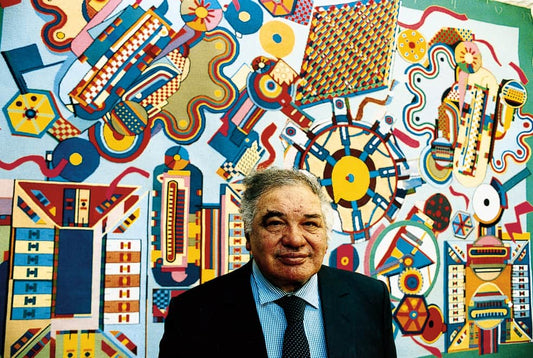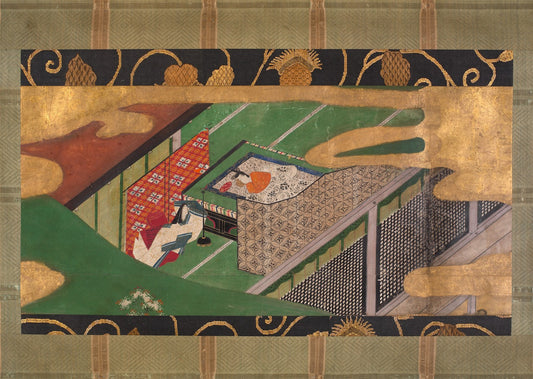Feature image: Jan van Helmont, Portrait of the sisters of the convent of the Black Canon Augustinian nuns of Antwerp, 1665 and 1714 via Wikipedia
Nuns in Art History
It wasn’t until the 16th century that individual artists began to find fame and widespread name recognition. Beforehand, artists labored in workshops, creating mostly anonymous pieces. There were only a handful of widely known artists prior to 1600, and of these, a small percentage were women. Perhaps surprisingly, it was nuns who became some of the first known and named female artists. Convents were often centers of artistic activities such as music, theater, literature, miniature paintings, and embroidery. A nun, Maria di Ormanno Degli Albizzi, is credited as one of the first female self-portraitists. Nuns’ ability to devote themselves to artistic pursuits can largely be explained by their having no need to perform the domestic responsibilities of marriage and motherhood, which were the purview of women outside the convent. Thus, nuns became pioneers of woman-made art in the Western world.
St. Catherine of Bologna (1413-1463)
St. Catherine of Bologna, canonized in 1712, is the patron saint of artists. She often turned to the arts as a method of devotion and is credited with painting many religious pictures. She was also known for decorating her breviary (a small liturgical prayer book). Generally, breviaries were not lavished with adornments, but St. Catherine of Bologna brightened hers with simple religious drawings. She felt that the creation of religious art would increase devotion for herself and those who viewed the work. Upon her death in 1463, her body was exhumed when other nuns smelled a sweet aroma coming from her grave, which was believed to be a talisman of holiness. Her body was found to be uncorrupted and was placed on display in the convent, where it has remained to this day.
Maria Eufrasia Della Croce (1597-1676)
Maria Eufrasia Della Croce was the daughter of a patrician and sister to an art collector. She painted with oil on plaster and is credited for creating many works for her convent, Saint Giuseppe a Capo le Case. She is also believed to have trained the artist Plautilla Bricci. One of her male contemporaries, Filippo de Rossi, said she was a “most excellent nun and painter of the place.” Another Bruzio, speaking about a nativity scene Croce painted, said, “Even if it is by a woman, it is not a displeasing work.” These two comments perfectly highlight how female artists were viewed during this time. Croce is referred to firstly as a nun and secondly as an artist. This was a common way that men diminished female artists' work and careers, a treatment that was never brought upon male artists. Croce also painted several altarpieces, which were considered the first woman-made artworks to be publicly displayed. While Maria’s works are referenced in academic writings, images of her paintings are not widely available due primarily to centuries-old church renovations.


Maria De Dominici (1645-1703)
Maria De Dominici hailed from a family of artists and studied under the painter Mattia Preti, with whom she assisted in some of his most famous works. Maria De Dominici was a strong and ambitious woman. She showed revulsion to her female duties and ignored them in pursuit of her art. She became a nun as a way to pursue her artistic desires, free from the pressures of marrying and having children. Her teacher, Preti, allowed her to paint many of the female figures in his pivotal work on the ceiling of the Church of St. John. Speaking of Dominici, Author Giuseppe Maria de Piro said, “She superseded any other of his (Mattia Preti’s) pupils, so much so that the celebrated master chose her to collaborate with him in painting the great vault of the church of St. John, in which the female figures were, to a great extent, executed by her.” Maria De Dominici eventually had her own studio in Rome, where she received many commissions.
Corita Kent (1918-1986)
Corita Kent was affectionately known as the “Pop Art Nun.” Her works were vibrant and drew international acclaim. While her early artwork explored figurative and religious imagery, she shifted focus toward strong political messages during the 1960s. Corita’s works reflected her concerns surrounding poverty, racism, and war. By the late 1960s, her work had been displayed at more than 230 shows, featured at civil rights and anti-war rallies, and had graced the cover of Newsweek. From Wonder Bread to the Beatles, Kent’s pieces referenced several pop culture touchstones. One example of this is her work Manflowers, which features an image of two young, wounded American soldiers from the Vietnam War. Under the image are two phrases, “MANPOWER” and “Where have All the flowers gone?” The question is taken from a popular song written by Peter Seeger, in which he mourns the loss of youth and grapples with wartime disillusionment. The two phrases, in conjunction with the image, speak to the vulnerability and loss of the two soldiers, who are seen rooted to the muddy battlefield. Kent entered the religious order Immaculate Heart of Mary at age 18, and eventually became the head of the art department at Immaculate Heart College. In total, Corita Kent created almost 800 serigraphs and thousands of watercolors.
Wendy Beckett (1930-2018)
Though not an artist herself, Sister Wendy Beckett was a beloved and popular art historian. She studied English at the University of Oxford and joined the Sister of Notre Dame de Namur at 16. In 1980, she began to immerse herself in the art world, working from reproductions and corresponding with art galleries and museums around the world. She made her first TV appearance in 1991 for a documentary on the National Gallery but didn't begin to gain popularity until a later TV series titled Sister Wendy’s Grand Tour, where she discussed art across Europe. By 1997, Sister Wendy’s popularity soared to international acclaim through the BBC series Sister Wendy’s Story of Painting. Her passion for art and expressive storytelling has made this series a beloved resource for art lovers everywhere.
Paula Mary Turnbull (1921-2018)
Paula Mary Turnbull was an educator and sculptor who became known as the “Welding Nun.” She studied at the University of Washington, The Art Institute in Chicago, and the Parsons School of Design in New York City. She is best known for her welded metal works (hence her moniker), but she has also created ceramics, watercolors, and wood carvings. Sister Paula lived at the Convent of the Sisters of Holy Names of Jesus and Mary in Spokane, Washington. It was also here that, as a result of her international fame, a studio was built exclusively for her on the convent grounds. She produced many beloved public art pieces, including the Garbage-Eating Goat, which is a metal goat that disposed of people's trash by sucking it away through the goat’s mouth. She created thousands of works over her life, was a beloved community member, and inspired younger artists.
Historically, convents created an ideal space for women to pursue their artistic desires free from the constraints of societal expectations of womanhood. Nuns have a long history in the world of art. They helped pave the way for future female artists and created a bond between nuns and art that has held fast.
©ArtRKL™️ LLC 2021-2024. All rights reserved. This material may not be published, broadcast, rewritten or redistributed. ArtRKL™️ and its underscore design indicate trademarks of ArtRKL™️ LLC and its subsidiaries.











